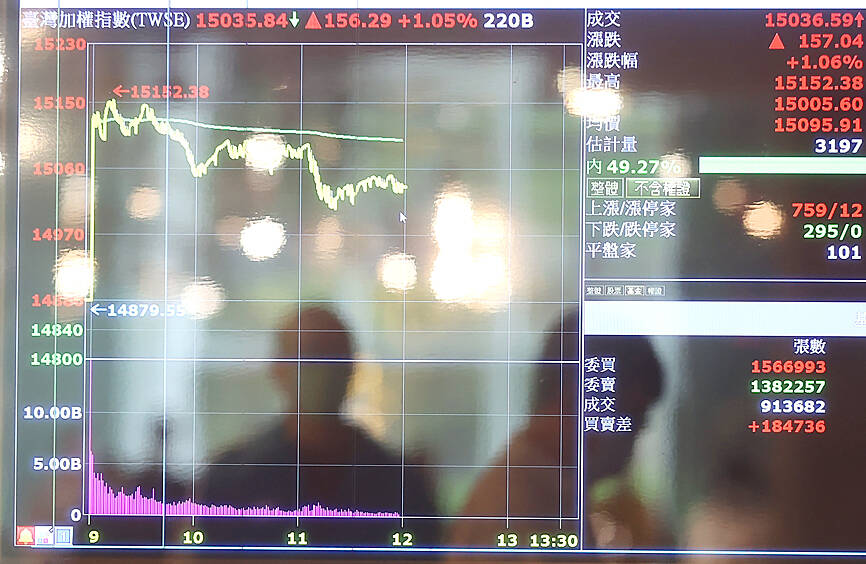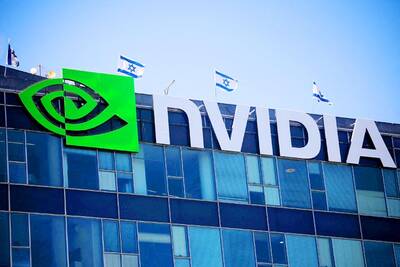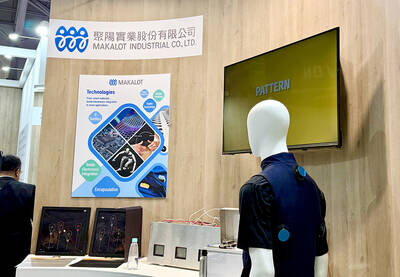Global banks are turning bullish on Taiwanese and South Korean shares, expecting a revival in semiconductors to drive a rally next year, while they see Japan’s market as resilient thanks in part to its weak currency.
The calls come as US rates are still rising, with most markets around the world eyeing their worst annual returns since the 2008 global financial crisis and with chipmakers’ profits cratering.
Goldman Sachs Group Inc said South Korean stocks are the bank’s top “rebound candidate” for next year due to low valuations, made cheaper by a nosediving won, and as companies benefit from an expected recovery in Chinese demand.

Photo: CNA
It expects a return in US dollar terms of 30 percent next year.
Morgan Stanley also gives South Korea top billing.
Together with Taiwan, it is the best place to be, as the two markets have a reputation as “early cycle” leaders in the demand recovery, the bank said.
Bank of America Corp, UBS Group AG, Societe Generale SA and Deutsche Bank AG’s wealth manager DWS Group are all bullish on South Korean stocks, with analysts’ conviction in that trade lying in sharp contrast to their divided view on India and China.
“In the semiconductor area, demand should bottom in the first quarter of next year and the market always starts to run before that,” said DWS Asia-Pacific chief investment officer Sean Taylor, who added South Korean exposure in recent months.
“We think [South Korean stocks] sold off too much in September and August,” he said.
South Korea’s benchmark KOSPI has lost about 17 percent this year and the won has declined 9 percent, although both have shown signs of recovery in recent months.
Goldman Sachs said that five years of selling has driven foreign ownership of South Korean stocks to its lowest level since 2009, but inflows of about US$6 billion since the end of June “indicates a turn in foreign interest” that could lift the market further.
Societe Generale’s recommendation for investors to increase their exposure to Taiwan and South Korea comes at the expense of China, India and Indonesia. Goldman’s preference for South Korean stocks comes as it has suggested a reduction in Brazil exposure. Morgan Stanley downgraded its view on Indian exposure in October, when it upgraded its recommendation for South Korea.
Morgan Stanley is most bullish on chipmakers turning out commoditized low-cost chips, as well as chips destined for consumer goods — including companies such as Samsung Electronics Co or SK Hynix Inc. Morgan Stanley has a price target for SK Hynix about 50 percent above the current share price.
Taiwan and Japan offer attractions for some similar and some novel reasons. Like South Korea, Taiwan is another heavily sold and chipmaker-dominated market — although tensions with China make some investors a bit less enthusiastic.
Goldman Sachs is underweight on Taiwanese stocks, citing geopolitical risk, while Bank of America is neutral and its most recent survey of Asian fund managers shows they are bearish.
Japan also offers chips exposure, as well as some security and diversification, with a weak yen also a tailwind for exporters and typically a boon for equities.
“A sustained stay at such undervalued levels, as expected by our FX strategists, augurs well for Japan equities,” said Bank of America analysts, who recommend overweight Japan.
Morgan Stanley, DWS and UBS are also positive, as is Goldman Sachs, especially for the second half when it forecasts inflows.
There is less agreement when it comes to China, where big investors seem to be in a wait-and-see mode, or India where investment houses feel an 8 percent rally for the benchmark SENSEX has left valuations a bit pricey.
Much of the banks’ investment calls rest on assumptions that US interest rates eventually stop going up and China eventually relaxes its COVID-19 rules.
Meanwhile, Taiwan and South Korea are both geopolitical flashpoints, but analysts said at least some of that is already in the price.
“There has been some political issue in both [South] Korea and Taiwan for a long time,” Societe Generale Asia equity strategy head Frank Benzimra said.
“Things can always get worse,” he said. “But in terms of the risk-reward, what we find is that a number of the lowly valued markets, whether it’s [South] Korea or Taiwan ... have more limited downside because of the accumulation of bad news that we have seen over the last 12 months.”

Shares in Taiwan closed at a new high yesterday, the first trading day of the new year, as contract chipmaker Taiwan Semiconductor Manufacturing Co (TSMC, 台積電) continued to break records amid an artificial intelligence (AI) boom, dealers said. The TAIEX closed up 386.21 points, or 1.33 percent, at 29,349.81, with turnover totaling NT$648.844 billion (US$20.65 billion). “Judging from a stronger Taiwan dollar against the US dollar, I think foreign institutional investors returned from the holidays and brought funds into the local market,” Concord Securities Co (康和證券) analyst Kerry Huang (黃志祺) said. “Foreign investors just rebuilt their positions with TSMC as their top target,

H200 CHIPS: A source said that Nvidia has asked the Taiwanese company to begin production of additional chips and work is expected to start in the second quarter Nvidia Corp is scrambling to meet demand for its H200 artificial intelligence (AI) chips from Chinese technology companies and has approached contract manufacturer Taiwan Semiconductor Manufacturing Co (TSMC, 台積電) to ramp up production, sources said. Chinese technology companies have placed orders for more than 2 million H200 chips for this year, while Nvidia holds just 700,000 units in stock, two of the people said. The exact additional volume Nvidia intends to order from TSMC remains unclear, they said. A third source said that Nvidia has asked TSMC to begin production of the additional chips and work is expected to start in the second

REVENUE PERFORMANCE: Cloud and network products, and electronic components saw strong increases, while smart consumer electronics and computing products fell Hon Hai Precision Industry Co (鴻海精密) yesterday posted 26.51 percent quarterly growth in revenue for last quarter to NT$2.6 trillion (US$82.44 billion), the strongest on record for the period and above expectations, but the company forecast a slight revenue dip this quarter due to seasonal factors. On an annual basis, revenue last quarter grew 22.07 percent, the company said. Analysts on average estimated about NT$2.4 trillion increase. Hon Hai, which assembles servers for Nvidia Corp and iPhones for Apple Inc, is expanding its capacity in the US, adding artificial intelligence (AI) server production in Wisconsin and Texas, where it operates established campuses. This

Garment maker Makalot Industrial Co (聚陽) yesterday reported lower-than-expected fourth-quarter revenue of NT$7.93 billion (US$251.44 million), down 9.48 percent from NT$8.76 billion a year earlier. On a quarterly basis, revenue fell 10.83 percent from NT$8.89 billion, company data showed. The figure was also lower than market expectations of NT$8.05 billion, according to data compiled by Yuanta Securities Investment and Consulting Co (元大投顧), which had projected NT$8.22 billion. Makalot’s revenue this quarter would likely increase by a mid-teens percentage as the industry is entering its high season, Yuanta said. Overall, Makalot’s revenue last year totaled NT$34.43 billion, down 3.08 percent from its record NT$35.52